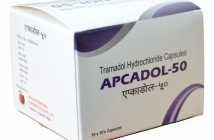Home / Categories / AMIXIDE-H

AMIXIDE-H
(10)
CHLORDIAZEPOXIDE-5MG
AMITRIPTYLINE-12.5MG
DRUGS ACTING ON CENTRAL NERVOUS SYSTEM-BENZODIAZEPINES + TRICYLIC ANTIDEPRESSANTS
SUN PHARMA LTD
Product Details
| Chlordiazepoxide/Amitriptyline |
| (klor-DIE-aze-ee-POX-ide/am-ee-TRIP-tih-leen) |
| Limbitrol DS 10–25 |
| Class: Psychotherapeutic combination |
 Action Amitriptyline blocks reuptake of serotonin and norepinephrine in CNS. Chlordiazepoxide potentiates effects of GABA in CNS.
Action Amitriptyline blocks reuptake of serotonin and norepinephrine in CNS. Chlordiazepoxide potentiates effects of GABA in CNS.
 Indications Treatment of moderate to severe depression associated with moderate to severe anxiety.
Indications Treatment of moderate to severe depression associated with moderate to severe anxiety.
 Contraindications Hypersensitivity to chlordiazepoxide or other benzodiazepines; hypersensitivity to amitriptyline or other tricyclic antidepressants; concomitant MAO inhibitor use; acute recovery phase of MI.
Contraindications Hypersensitivity to chlordiazepoxide or other benzodiazepines; hypersensitivity to amitriptyline or other tricyclic antidepressants; concomitant MAO inhibitor use; acute recovery phase of MI.
PO 1 tablet (10 mg chlordiazepoxide with 25 mg amitriptyline) tid or qid. May increase to 6 tablets daily if needed; some patients may respond to 1 tablet bid.
Cimetidine, fluoxetine, haloperidol, phenothiazine antipsychotic compounds, oral contraceptives: May cause increased amitriptyline blood levels. Cimetidine, oral contraceptives, disulfiram, fluoxetine, isoniazid, ketoconazole, metoprolol, propoxyphene, propranolol, valproic acid: May increase chlordiazepoxide effects. Clonidine: May result in hypertensive crisis. CNS depressants, alcohol: Depressant effects may be additive. Digoxin: May increase digoxin serum levels. Guanethidine: May diminish antihypertensive effects. MAO inhibitors: May result in hypertensive crises, convulsions and death. Oral anticoagulants: May result in increased anticoagulant effect.
 Lab Test Interferences None well documented.
Lab Test Interferences None well documented.
CV: Hypotension; hypertension; tachycardia; palpitations; MI; arrhythmias; heart block; ECG changes; stroke. CNS: Hallucinations; hypomania; delusions; poor concentration; incoordination; tingling and paresthesias of extremities; extrapyramidal symptoms; syncope; changes in EEG patterns; dizziness; sedation; drowsiness; headache; lethargy; fatigue. DERM: Rash; urticaria; photosensitivity; edema of face and tongue; pruritus. EENT: Pupil dilation; blurred vision; nasal stuffiness; alteration in taste perception; parotid swelling. GI: Nausea; epigastric distress; vomiting; anorexia; diarrhea; black tongue; bloating; dry mouth; constipation. GU: Testicular swelling; decreased urinary frequency; menstrual irregularities; loss of bladder function; change in sex drive. HEMA: Bone marrow depression including agranulocytosis; eosinophilia; purpura; thrombocytopenia. HEPA: Jaundice; hepatic dysfunction; increased AST, ALT, alkaline phosphatase. META: Elevation or depression of glucose levels. RESP: Difficult breathing. OTHER: Weight gain or loss; paradoxical sweating; gynecomastia; breast enlargement and galactorrhea (women); syndrome of inappropriate antidiuretic hormone secretion.
Pregnancy: Pregnancy category undetermined. Lactation: Excreted in breast milk. Children: Not recommended in children < 12 yr. Elderly or debilitated patients: Unit dosage to smallest effective amount to decrease risk of ataxia, oversedation, confusion or anticholinergic effects. Special risk patients: Use with caution in patients with history of seizures, urinary retention, urethral spasm, angle-closure glaucoma or increased intraocular pressure, cardiovascular disorders and hepatic or renal impairment; hyperthyroid patients or those receiving thyroid medication; schizophrenic or paranoid patients.
| PATIENT CARE CONSIDERATIONS |
|
- If patient has been taking MAO inhibitor, wait 2 wk before beginning limbitrol therapy. Cautiously begin treatment with reduced dosage.
- Therapy may begin with 1 tablet at bedtime with dosage titrated upward as tolerance to CNS depressant effect develops.
- Administer with food or water to reduce gastric irritation.
- Give larger portion of total daily dose at bedtime.
- Store in moisture-resistant container at room temperature.
- Obtain patient history, including drug history and any known allergies, especially to drug, amitriptyline or other benzodiazepines.
- Evaluate medical history for potential risk of drug or alcohol abuse or suicide.
- If elective surgery is planned, drug should be discontinued several days before surgical procedure.
- If patient is addiction prone or suicidal, remain with patient while patient takes tablet. Observe for signs of hoarding.
- Closely monitor patients with history of hyperthyroidism or patients taking thyroid medication.
- Monitor BP and pulse during initial therapy.
- If patient is undergoing long-term treatment, perform periodic blood counts and liver function studies.
|
||||
- Instruct patient to avoid intake of alcoholic beverages and other CNS depressants because additive effects can cause dangerous level of sedation and CNS depression.
- Advise patient that drug may cause drowsiness and to use caution while driving or performing other tasks requiring mental alertness.
- Instruct patient not to discontinue medication abruptly or change dosage without consulting with physician because withdrawal symptoms can occur.
- Caution patient to avoid excessive exposure to sunlight and to use sunscreen or wear protective clothing to avoid photosensitivity reaction.
- Advise patient that dry mouth may occur and that it may be relieved by taking sips of water frequently or sucking on hard sugarless candy or gum.
- Caution patient not to take any otc medications without consulting physician.
Books@Ovid
Copyright © 2003 Facts and Comparisons
David S. Tatro
A to Z Drug Facts
 Route/Dosage
Route/Dosage Interactions
Interactions Adverse Reactions
Adverse Reactions Precautions
Precautions Administration/Storage
Administration/Storage Assessment/Interventions
Assessment/Interventions Patient/Family Education
Patient/Family Education


